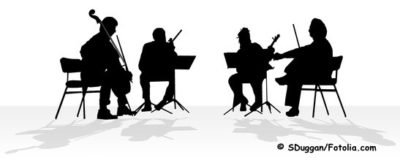My husband and I happened to be in Minneapolis a month ago just as the Minnesota Orchestra was beginning its 2019-2020 season, and we went to the opening concert. The concert, with music by Rautavaara, Grieg, Carter, and Elgar, opened with The Star-Spangled Banner, and all 1800 people in the audience immediately rose to their feet and began singing. Minnesota has a strong choral tradition, everyone sang at full voice, and the sound of those 1800 voices nearly lifted me off my feet. It was an emotional experience, and even though I didn’t know anyone there, the singing together of the national anthem made me feel part of a larger community. And, in fact, studies show that people who make music together are more likely to cooperate and feel more connected as a group.

The business world has long been aware of “connectedness through music” and has used string quartets as examples of “self-management teams.” Many string quartets supplement their musical performance schedules with presentations to companies and organizations exploring teamwork, problem solving, reliability, trust, discipline, and flexibility within the quartet as an example of how an excellent small team works. You hear the result of that group “connectedness” in the music as they perform. Success depends on an extraordinary level of teamwork.
Curiously, our Paleolithic ancestors seemed to understand perhaps better than we do today that music helped them work together as a group, whether it was to go on a successful hunt or to face a common enemy. As I wrote about in How Old is Music? and Music and Prehistoric Cave Art, flutes in pentatonic tuning dating to 40,000 BCE have been found in Paleolithic caves in Germany. Caves in France, Germany and Spain all have prehistoric cave paintings in large chambers with flutes found either in the chamber or at the mouth of the cave.

Archaeologists, anthropologists and art historians all believe that paintings were drawn in the large chambers of the cave where music would be the most resonant, and that playing the flutes, with perhaps singing and dancing together as a group was used in ritual celebrations that may have celebrated a successful hunt, appealed to the spirits to increase the animal herd, or prepared them to face the enemy. Increasing numbers of researchers who study the origins of music believe that music was important for group bonding in early societies and therefore has an evolutionary basis.
We still participate in a lot of rituals involving music that promote group bonding. We incorporate chanting and singing in our religious rituals, we sing the National Anthem before athletic events (and sometimes concerts), large numbers of people dance in time to a favorite band, or sway in time at a rock concert. There is a shared experience in experiencing music together and it makes people more likely to cooperate with each other.
Being “in sync” and teamwork
Stanford psychologists Scott Wiltermuth and Chip Heath conducted a series of experiments to see how being in sync would affect interactions of a group. In the first experiment, two groups of participants walked around the Stanford campus. One group walked in-step and the other group walked normally. No music was involved in this part of the study.
Later they played an economics game, which as far as the participants knew, had no connection to the walk they took around campus. The game actually measured expectations of cooperation, and the results showed that the participants who had walked in sync trusted their counterparts more and felt more connected to them as a group than did the participants who had just walked normally. This is no doubt why the military continues to train by marching in formation, even though that would be deadly on the battlefield. But they know that marching in sync builds group cohesion.
In the 2nd experiment, participants sang along to “Oh, Canada,” heard through headphones, although these participants were American, not Canadian. While singing, they moved cups back and forth in time. Members of one group all heard the music at the same tempo at the same time, so they moved their cups synchronously. Participants in another group heard the music at different tempos, so they were not singing together or moving their cups synchronously.
Again, an economics game followed that participants did not know was connected to the first part of the experiment. And again, those who had synchronized to the music in the first part of the experiment not only cooperated more, but as a result, received larger payoffs in the game.
In the 3rd experiment, the first stage was the same, participants singing and moving cups either synchronously or asynchronously. But the game that followed was designed so that participants could put tokens in a public account or keep the tokens for themselves. Those who had synchronized to the music not only made more contributions over time to the public account, they reported stronger feelings of being on the same team.
Societies, such as that of our Paleolithic ancestors, rely on cooperation or teamwork among their members in order to thrive and be successful. That kind of cooperation is what allowed civilization to flourish. There has been no society at any time in history that has been able to survive without cooperation and teamwork. The authors conclude that “synchrony rituals may have therefore endowed some cultural groups with an advantage in societal evolution, leading some groups to survive where others have failed.” And music is a large part of those synchrony rituals.
Brains in sync
While the Stanford study didn’t look at the brains of the participants, a study from 2009 looked at the brains of two guitarists and found that their brain waves synchronized as they played together (See Making music together syncs brains). These were guitarists who had never played together previously, but as soon as they heard the beat of a metronome prior to playing, their brain waves began to sync with each other and continued in sync as they played.
What’s interesting is that these were not beta or gamma waves, the waves associated with conscious thought. We might expect those waves to sync as we think about, and make a conscious effort, to be together with another musician with whom we are playing. The waves that were in sync were the theta and delta waves, the low frequency waves that are associated with drowsiness and sleep – our unconscious brain. So the brain waves of the two guitarists were syncing at an unconscious level.
I suggested in the blog post referenced above that, since our brains are syncing below the level of consciousness with other musicians when we make music, perhaps we are hardwired to make music. Our Paleolithic ancestors seemed to understand the importance of making music together to survive, so perhaps that is part of our evolutionary history.
Not only do our brains sync when making music, and listening to or making music together makes us more likely to bond as a group or team, but moving in time with others even affects the social behavior of babies who are barely able to walk.
Being in sync, babies, and helpful behavior

Laura Cirelli and Laurel Trainor in the Department of Psychology, Neuroscience & Behavior at McMaster University showed that 14-month old babies were much more likely to help another person after they had bounced up and down in time to music with that person.
68 infants participated in the study. One researcher (called the assistant) held the baby in a forward-facing carrier while another researcher (the experimenter) stood facing the infant. The baby heard a MIDI version of the Beatles “Twist and Shout” over loudspeakers. The assistant holding the infant was wearing headphones and heard a click track coordinated with “Twist and Shout” to which she bounced the baby.
The experimenter facing the infant also heard a click track through headphones, sometimes in sync with “Twist and Shout,” sometimes not, and she would bounce with the click track. So sometimes that meant the experimenter was in sync with the infant, sometimes not.
When the song finished, the experimenter who had been facing the baby and either bouncing in sync or not, began the second part of the experiment, which had to do with helping tasks. In one, she began to draw a picture with a marker, but “accidentally” dropped the marker on the floor. In a second, she tried to pick up paper balls with tongs and place them in a basket, but they were slightly out of reach. In the third, she clipped dishcloths on a clothesline but “accidentally” dropped the clothespins.
The babies who had been bounced in time with the experimenter were far more likely to toddle over to the object, pick it up and hand it to the experimenter than were the infants who had been bounced out of sync. Cirelli believes this is significant because it shows that moving together to music with others encourages the development of altruistic behavior within a group.
Being in sync, altruistic behavior, teamwork – all promoted through music.
*****